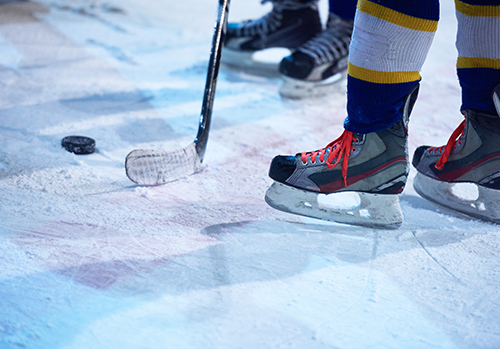
Photo courtesy of Story Blocks
5 Unique Hockey Traditions
The National Hockey League (NHL) is deep into its postseason, and viewers are bound to witness many of the league’s unique hockey traditions. You may have never watched a hockey game before, or perhaps you are a seasoned fan. Regardless, sit back and prepare to learn several origins and the details behind five unique hockey traditions.
Hockey Traditions: Playoff Beards
If you are tuning into the NHL playoffs, you will certainly see players donning playoff beards. Hockey players annually grow full untouched beards, goatees, handle-bar mustaches, occasionally trimmed beards, and everything in between. Where did this tradition begin? Sportswriters attribute the playoff beard to the 1980 New York Islanders. The players believed the facial hair brought them good luck on their way to winning the Stanley Cup championship trophy. The Islanders would win four consecutive championships from 1980-1983. An unwritten rule of the playoff beard states that players shave minimally or not shave at all until their opponents eliminate them from the postseason. The unique hockey tradition has also emerged in minor league, college, and high school play. Fans are also encouraged to grow playoff beards.
Handshake Line Tradition
Another special hockey tradition occurs at the end of a playoff series. Handshake lines feature opposing teams forming a line on either side of the center ice to conduct traditional handshakes and express congratulations to the winners or yield a ‘good series’ type of acknowledgment. A 1908 newspaper clipping notes the first documented handshake line at an All-Star game for an amateur hockey association. By the 1920s, the tradition had carried over to the NHL. Other sports might display coaches or a handful (pun intended) of players shaking hands, but this unique hockey tradition involves every team member and coach.
Hat Trick Traditions
When a skater scores three goals in one game, the achievement is called a hat trick. Since the 1950s, fans across the NHL have ceremoniously launched their hats and caps onto the ice after a home player’s third goal in a contest. An 1858 cricket match established the first hat trick when a bowler struck the wooden stakes behind the batter in three consecutive hurls. The rare feat prompted people to gather money to purchase a hat for the bowler. Hockey’s hat trick term appeared in newspapers in the 1930s and early 1940s. Hockey Hall of Fame officials tie the hat trick origin to the tale of Toronto business owner Sammy Taft. The businessman offered a free hat to any player who scored three goals in a game in the city of Toronto. Folklore says that 1946 Chicago Black Hawks forward Alex Kaleta walked into Taft’s shop and desired a fedora but did not have the money to pay for it. The Toronto shopkeeper offered the hat to Kaleta for free if he scored three goals that evening. Kaleta proceeded to tally four goals and secured the fedora. Today, if you toss your hat onto the ice, do not expect to get your hat back. Home teams donate those hats to local charities.
Towel Power
Today, waving a hand towel in the stands commonly occurs in almost any sporting venue. The fans wave towels to show their support for the team or to appear as a united crowd. Yet, in the 1982 Stanley Cup playoffs, the first time a towel wave occurred in hockey, the action meant something different. In Game 2 of the Western Conference Finals, Vancouver Canucks Head Coach Roger Neilson disagreed with several referee decisions that penalized his team in their road game. Neilson decided to hold up a hockey stick above his head with a white towel on the top and waved it to symbolize a sign of surrender to the referees. The officials ejected him from the contest for his actions. Vancouver fans were so inspired by Neilson that at the next home game, Canucks fans waved white towels to support their team and coach. In 2011, nearly 30 years later, a bronze statue of Roger Neilson in his rebellious act was unveiled outside the Vancouver Canucks’ arena.
Hockey Traditions: Don’t Touch the Trophy
Our final unique hockey tradition is a superstitious practice. Superstitions vary among hockey players and athletes in any sport, but this one resides specifically among hockey competitors. Many, if not all, hockey players refuse to touch the Stanley Cup before winning the championship. Additionally, some participants refuse to be in the same room with the championship trophy. In 1997, this hockey tradition went a step further when the victorious Philadelphia Flyers refused to touch their conference championship trophy. The premise behind the lack of action was to avoid spoiling their chances of winning the Stanley Cup in the final round of the playoffs. Philadelphia would lose in the final round despite choosing not to celebrate with the Western Conference trophy.
If you found this article intriguing, please read about bicycling advantages.
Have Health Insurance Questions?
We hope that this information on hockey traditions is interesting to you.
Insurance is oftentimes overwhelming, and we want to shed light on the industry by answering your questions. Comment below and your question may be the topic of our next post!
If you liked this article, share it with your friends!
Empower Brokerage wants to help you find the insurance coverage you need and help you save money getting it. Stay on top of your health and give us a call at (844) 410-1320.
Get affordable health insurance quotes by clicking here.
See our other websites:

